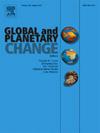Dust emissions in the arid Asian interior and abrupt changes in midlatitude atmospheric circulation during the glacial-Holocene transition
IF 4
1区 地球科学
Q1 GEOGRAPHY, PHYSICAL
引用次数: 0
Abstract
Loess deposits from the Kunlun Mountains provide high-resolution eolian dust archives that allow us to understand past dust emission patterns in the Asian interior, and associated abrupt atmospheric circulation changes during the glacial-Holocene transition. Coarse-grained particles from this area (site AQ16) offer evidence of frequent dust plumes on millennial to centennial timescales in the Tarim Basin. Abrupt dust flux fluctuations during this transition, particularly during the Younger Dryas (YD), exhibit co-variation patterns similar to those seen in dust records from West Asia, East Asia, and Greenland, suggesting intercontinental climate teleconnections through the boreal westerly jet. We observe an anomalously high dust flux during the YD, not correlated with grain size. We attribute this circumstance to a stagnant westerly jet over the Tarim Basin for an extended period, leading to a prolonged duration of dust events. This could be due to a weakened Atlantic Meridional Overturning Circulation that triggered a southward shift and strengthening of the westerly jet, in conjunction with the North Atlantic Oscillation. These findings have broad implications for understanding regional dust emission dynamics and the coupling between dust emissions and atmospheric circulation on a global scale during the transition from the last glacial to the early Holocene.
求助全文
约1分钟内获得全文
求助全文
来源期刊

Global and Planetary Change
地学天文-地球科学综合
CiteScore
7.40
自引率
10.30%
发文量
226
审稿时长
63 days
期刊介绍:
The objective of the journal Global and Planetary Change is to provide a multi-disciplinary overview of the processes taking place in the Earth System and involved in planetary change over time. The journal focuses on records of the past and current state of the earth system, and future scenarios , and their link to global environmental change. Regional or process-oriented studies are welcome if they discuss global implications. Topics include, but are not limited to, changes in the dynamics and composition of the atmosphere, oceans and cryosphere, as well as climate change, sea level variation, observations/modelling of Earth processes from deep to (near-)surface and their coupling, global ecology, biogeography and the resilience/thresholds in ecosystems.
Key criteria for the consideration of manuscripts are (a) the relevance for the global scientific community and/or (b) the wider implications for global scale problems, preferably combined with (c) having a significance beyond a single discipline. A clear focus on key processes associated with planetary scale change is strongly encouraged.
Manuscripts can be submitted as either research contributions or as a review article. Every effort should be made towards the presentation of research outcomes in an understandable way for a broad readership.
 求助内容:
求助内容: 应助结果提醒方式:
应助结果提醒方式:


